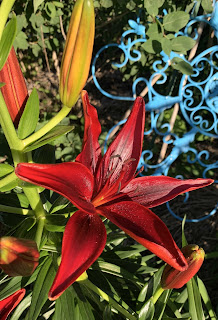ProfessorRoush seems to have slipped comfortably back into his continuing role as the
unofficial photographer of the Extension Master Gardener's Manhattan Area Garden tour, albeit with a break during the skipped tour last year due to the pandemic cancellation of the Tour. I won't comment here on the folly of canceling a GARDEN tour in a time when more of the population would have attended then ever, but that's all rain clouds and opportunities missed.
Most importantly, I had planned to share in this blog what I thought were the 6 best photos from this year's tour, however, as usual, I'm failing miserably. It's fairly easy, among 609 photos taken in 4 hours today, for me to weed out all the pictures with identifiable people in them since I shouldn't/can't post people without permission. And my best intentions to catch a bee in the act of nefarious nectar collection went awry several times today; it was cloudy for most of the tour and the camera shutter speed just wasn't up to catching them as a still life.

It is more difficult than I anticipated to choose the best from the 50 or so daylily pictures and the various vignettes of gnomes and garden ornaments and from the delightful plant arrangements that were everywhere. Ego aside, many of the pictures are quite good, despite the overcast and early start to the day. My goal of posting six photos became a battle to narrow down from 50, and then from 20, until I settled on these 8. Well, on these 9 if you count the last wanna-be. Who, anyway, could resist this bronze heron sculpture at the K-State Gardens in the middle of the created wetlands?

Every photo here is unedited, just as I took them. Normally I would have cropped them for the blog, maybe removing some of the blurred green space at the top of the picture of the fancy echinacea at the left, and perhaps reducing their size, but I thought you'd like them in all their vivid detail. Point and click if you want to see them larger. I apologize, in advance, for the multi-megabyte nature of this blog entry, but most these days don't have the limitations we used to have on download speed, do they? I hope not.
Trains seemed to be the "thing" for the day and model railroads were laid out at two of the 6 gardens on the tour. ProfessorRoush perhaps didn't fully appreciate their contribution to the garden, but the many children on the tour certainly enjoyed them. I just kept thinking, "Okay, that's cute, but after a few times around the track, what would I do with it then?" To each, their own tracks, I suppose.
With the garden tour a few weeks later in the year than normal, the daylilies were blooming everywhere. I thought the prettiest daylily photograph that I took was of the pair shown at the top of this blog, but for a single entry, this yellow and purple-eyed daylily was too perfect to ignore.
There was plenty of wildlife in the gardens today, with one garden featuring a box turtle enclosure with a half-dozen unfortunately photo-shy turtles. I couldn't share the picture of one owner calling to her turtle, and a soundless still photo wouldn't do the moment justice anyway, but I can share these two sister felines who were intently hunting and torturing a vole in a garden. Their actions seemed to dismay the garden owner, but then, cats will be cats, won't they?

I loved this quiet pathway fork, lit by the Japanese Maple on one side and shadowed by the 'Forest Pansy' redbud that hung above it all. I was quite captivated by the light coming through the multi-colored leaves of 'Forest Pansy' and so the tour will cost me in real monetary terms since I'll have to seek one out now. This was a hard area to catch without people walking through it, but thankfully, if you can identify the legs of the two ladies taking the fork on the right, then you're far more observant, or intimately knowledgeable of these ladies, than I am.

I'll close with this almost-picture of the Monarch butterfly on milkweed. When the Monarch landed within reach of my lens, fluttering it's wings as it settled for a snack, I was adamantly sure I was about to get the perfect photo for the day, the crowning jewel of my efforts. For a brief instant, I was still, waiting for this beauty to open its wings so I could capture that instant of miracle, of life and ecology in a single picture. And then a nearby bumblebee came in like a Stuka dive bomber and the butterfly was gone, beyond my reach,
before my reflexes could trigger the shutter. Such are the disappointments that come hand-in-hand with these many glorious photos. Maybe next year. Or the year after.




















































